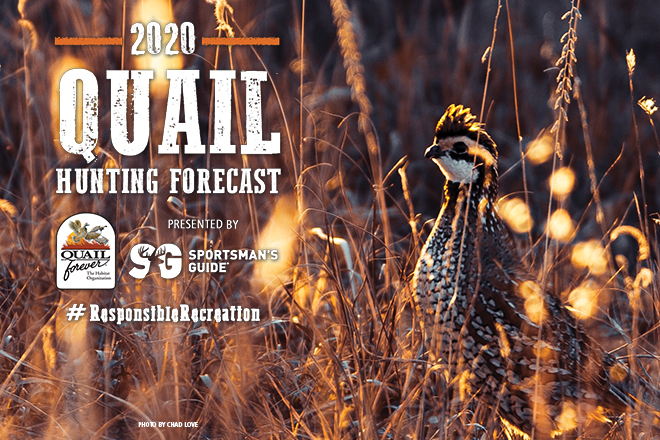 Editor's Note: If you’re reading this forecast, that means you have a passion for quail. Turn that passion into support by joining, renewing, or upgrading your membership Quail Forever. We are in the business of making habitat for the birds you love. Since its inception in 2005, QF has impacted over 1 million acres of habitat through its chapter volunteers, staff and partnerships. We ARE making a difference, and with your help, we can ensure our children will know the thrill of a staunch dog and a rising covey. Give back to the birds that give us all so much and show your support. Join, renew or extend your membership, and for a limited time get an awesome QF hoodie as our special gift to you!
Editor's Note: If you’re reading this forecast, that means you have a passion for quail. Turn that passion into support by joining, renewing, or upgrading your membership Quail Forever. We are in the business of making habitat for the birds you love. Since its inception in 2005, QF has impacted over 1 million acres of habitat through its chapter volunteers, staff and partnerships. We ARE making a difference, and with your help, we can ensure our children will know the thrill of a staunch dog and a rising covey. Give back to the birds that give us all so much and show your support. Join, renew or extend your membership, and for a limited time get an awesome QF hoodie as our special gift to you!
Like many other midwestern agriculture states, Indiana has suffered a long-term decline in upland habitat and overall bobwhite quail numbers in recent decades. However, a relatively mild winter and higher call counts in some areas mean there may be pockets of good news for Hoosier State quail hunters.
WEATHER AND CONDITIONS
"Based on NOAA data, the winter weather throughout Indiana was mild through at least December,” says Matt Broadway, small game research biologist with the Indiana Department of Natural Resources. “In most areas where weather stations record this data, average daily temperatures were at least 4 degrees higher than normal. Precipitation and snow events were also less severe. That said, we did experience one significant snow event in central Indiana and 1-2 significant rain events lasting more than one day."
According to Broadway, it’s possible some birds succumbed to extreme weather, or predation, during those times, but any losses were likely no lower than normal given the relatively mild weather throughout winter.
"We also saw above average temperatures in late winter with less severe rainfall events in many portions of the state eventually leading to a dry spring and summer.”
Based on spring counts, Broadway says it seems adult birds survived well.
“We detected a higher than average number of calling males during our surveys and given the dry spring and summer, we expect reproduction to be at least average. We didn't see jumps everywhere, but the typically better areas of the state; southwest, south-central, parts of the southeast, appeared more likely to increase, which we would expect.”
HABITAT, BROODS AND COUNTS
According to Broadway, a few anecdotal reports of higher-than-normal brood counts and late broods suggest a good production year, at least in some regions, but the hard data isn’t quite in yet.
“We do annual whistle call surveys throughout the state on at least 65 routes,” explains Broadway, “but those results are not published to our website as of yet.”
TOP SPOTS
Broadway says the farther south you go, the better your odds.
“Private land in the south-central area near the Kentucky border is good, along with the southwest portion of the state, if you can get access.”